WWII GERMAN INSIGNIA PATCH NUCLEAR DOCTOR KRIEGSMARINE SPECIALIST 2nd Armored

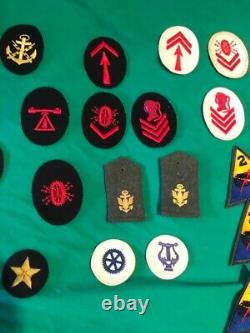
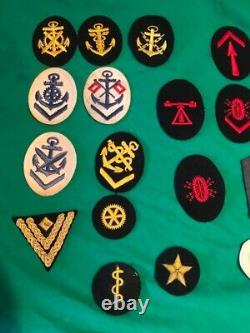
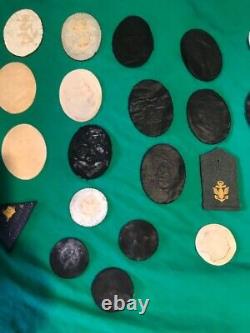
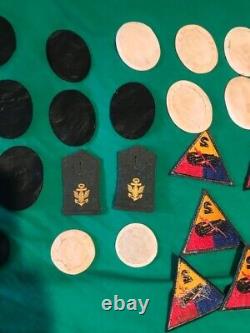


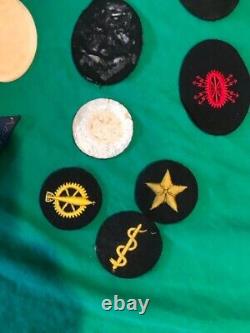
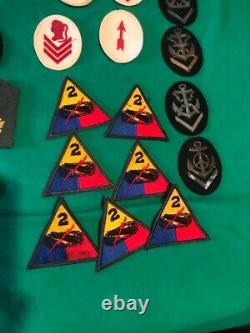
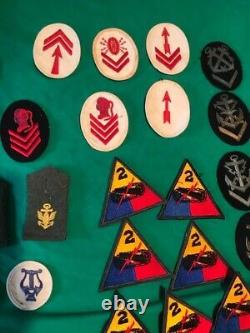
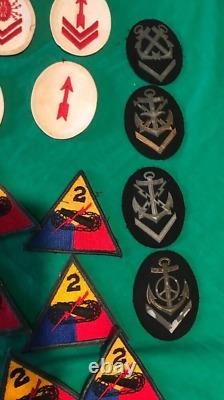

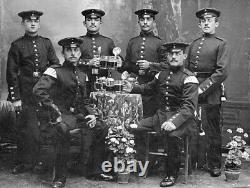

1917 WWI OLD CABINET PHOTO 666 BATTALION ARMY TRAINING PICTURE MILITARY POLICE? MUSEUM QUALITY WWII GERMAN INSIGNIA PATCH NUCLEAR DOCTOR KRIEGSMARINE SPECIALIST.
We welcome any comments, questions, or concerns. WE ARE TARGETING A GLOBAL MARKET PLACE. Thanks in advance for your patronage. Please Be sure to add WDG to your favorites list! NOW FOR YOUR VIEWING PLEASURE.
HUGE LOT OF AVIATOR BADGES. THESE HAVE BEEN IN A PRIVATE COLLECTION FOR NEAR 40 YEARS. (7) UNITED STATES 2ND ARMORED DIVISION.
Seamen Specialists (Blue 0n White) Summer Uniform. NCO Petty Officer Clerical / Clerk. NCO Petty Officer Signal Corp Signalsmans Laufbahnabzeichen. Seamen Specialist (Yellow on Blue). Seaman (older piece / embroidered, possibly closer to WWI).
NCO Petty Officer Medical Sick Berth Sanitsmaat. TELETYPIST NCO'S CAREER SLEEVE INSIGNIA. Kriegsmarine Specialist Trade (Red on Blue). KRIEGSMARINE TRADE SPECIALISTS (Red on White).
KRIEGSMARINE ELECTROMOTORS SPECIALIST TRADE PATCH 2nd Petty Officer. HYDROPHONE NCO'S SPECIALTY TRADE BADGE. ANTI-AIRCRAFT SEARCH LIGHT CONTROLLER'S SPECIALTY TRADE BADGE. ANTI-AIRCRAFT SOUND LOCATOR'S SPECIALTY TRADE BADGE.
(2) WW2 GERMAN NAVY OFFICER'S UNIFORM CAP WAFFEN EAGLE PATCH / BADGE. Kriegsmarine Oberstabsgefreiter's Rank chevron is in excellent condition with no mothing or damage. WWII WW2 KRIEGSMARINE WEHRMACHT MILITARY GERMAN NAVY NAVAL DEEP-SEA DIVER PATCH. NCO Officer Metal on Clothe Board Cyphers. On entering Kriegsmarine service all personnel were assigned and trained for a specific career. These careers consisted of a wide variety of specialty trades and functions with some of the careers restricted to certain rank groups. On successful completion of the appropriate training, personnel were issued distinctive career insignia to be worn on the upper left sleeve of the uniforms.For EM/NCO's the career insignia could be worn combined with the rank insignia or as separate insignia. Enlisted ranks of Matrose up to and including Hauptgefreiter career insignia were generally embroidered on small, round, bases while NCO ranks of Maat up to and including Oberdeckoffizier career insignia were on larger, vertically oval bases and could come in embroidered or stamped alloy versions. Regulations dictated that the base color of the insignia was to match the color of the uniform it was worn on. BEST OFFER WITHIN 30 DAYS WILL BE THE WINNER.
The following listing is a consignment, and the original collector is deceased. We try to thoroughly describe and identify the item.
Please ask questions, make comments and use your best discretion. We are guaranteeing our items to be accurate and want our buyers pleased and happy to come back. World War I (WWI or WW1), also known as the First World War or the Great War, was a global war centered in Europe that began on 28 July 1914 and lasted until 11 November 1918. More than 9 million combatants and 7 million civilians died as a result of the war, a casualty rate exacerbated by the belligerents' technological and industrial sophistication, and tactical stalemate.
It was one of the deadliest conflicts in history, paving the way for major political changes, including revolutions in many of the nations involved. The war drew in all the world's economic great powers, which were assembled in two opposing alliances: the Allies (based on the Triple Entente of the United Kingdom, France and the Russian Empire) and the Central Powers of Germany and Austria-Hungary. Although Italy had also been a member of the Triple Alliance alongside Germany and Austria-Hungary, it did not join the Central Powers, as Austria-Hungary had taken the offensive against the terms of the alliance. These alliances were reorganised and expanded as more nations entered the war: Italy, Japan and the United States joined the Allies, and the Ottoman Empire and Bulgaria the Central Powers.Ultimately, more than 70 million military personnel, including 60 million Europeans, were mobilised in one of the largest wars in history. The immediate trigger for war was the 28 June 1914 assassination of Archduke Franz Ferdinand of Austria, heir to the throne of Austria-Hungary, by Yugoslav nationalist Gavrilo Princip in Sarajevo. This set off a diplomatic crisis when Austria-Hungary delivered an ultimatum to the Kingdom of Serbia, and entangled international alliances formed over the previous decades were invoked.
Within weeks, the major powers were at war and the conflict soon spread around the world. On 28 July, the Austro-Hungarians declared war on Serbia and subsequently invaded. As Russia mobilised in support of Serbia, Germany invaded neutral Belgium and Luxembourg before moving towards France, leading Britain to declare war on Germany. After the German march on Paris was halted, what became known as the Western Front settled into a battle of attrition, with a trench line that would change little until 1917. Meanwhile, on the Eastern Front, the Russian army was successful against the Austro-Hungarians, but was stopped in its invasion of East Prussia by the Germans.
In November 1914, the Ottoman Empire joined the Central Powers, opening fronts in the Caucasus, Mesopotamia and the Sinai. Italy joined the Allies in 1915 and Bulgaria joined the Central Powers in the same year, while Romania joined the Allies in 1916, and the United States joined the Allies in 1917. The Russian government collapsed in March 1917, and a subsequent revolution in November brought the Russians to terms with the Central Powers via the Treaty of Brest Litovsk, which constituted a massive German victory until nullified by the 1918 victory of the Western allies. After a stunning Spring 1918 German offensive along the Western Front, the Allies rallied and drove back the Germans in a series of successful offensives. On 4 November 1918, the Austro-Hungarian empire agreed to an armistice, and Germany, which had its own trouble with revolutionaries, agreed to an armistice on 11 November 1918, ending the war in victory for the Allies. By the end of the war, four major imperial powers-the German, Russian, Austro-Hungarian and Ottoman empires-ceased to exist.The successor states of the former two lost substantial territory, while the latter two were dismantled. The maps of Europe and Southwest Asia were redrawn, with several independent nations restored or created. During the Paris Peace conference, The Big Four imposed their terms in a series of treaties. The League of Nations was formed with the aim of preventing any repetition of such an appalling conflict.
This aim, however, failed with weakened states, economic depression, renewed European nationalism, and the German feeling of humiliation contributing to the rise of nazism. These conditions eventually contributed to World War II.
From the time of its start until the approach of World War II, it was called simply the World War or the Great War and thereafter the First World War or World War I. In Canada, Maclean's Magazine in October 1914 said, Some wars name themselves. This is the Great War. The term "First World War" was first used in September 1914 by the German philosopher Ernst Haeckel, who claimed that there is no doubt that the course and character of the feared'European War'... Will become the first world war in the full sense of the word.
After the onset of the Second World War in 1939, the terms World War I or the First World War became standard, with British and Canadian historians favouring the First World War, and Americans World War I. In the 19th century, the major European powers had gone to great lengths to maintain a balance of power throughout Europe, resulting in the existence of a complex network of political and military alliances throughout the continent by 1900. These had started in 1815, with the Holy Alliance between Prussia, Russia, and Austria. Then, in October 1873, German Chancellor Otto von Bismarck negotiated the League of the Three Emperors (German: Dreikaiserbund) between the monarchs of Austria-Hungary, Russia and Germany.
This agreement failed because Austria-Hungary and Russia could not agree over Balkan policy, leaving Germany and Austria-Hungary in an alliance formed in 1879, called the Dual Alliance. This was seen as a method of countering Russian influence in the Balkans as the Ottoman Empire continued to weaken. In 1882, this alliance was expanded to include Italy in what became the Triple Alliance.Bismarck had especially worked to hold Russia at Germany's side to avoid a two-front war with France and Russia. When Wilhelm II ascended to the throne as German Emperor (Kaiser), Bismarck was compelled to retire and his system of alliances was gradually de-emphasised.
For example, the Kaiser refused to renew the Reinsurance Treaty with Russia in 1890. Two years later, the Franco-Russian Alliance was signed to counteract the force of the Triple Alliance. In 1904, Britain signed a series of agreements with France, the Entente Cordiale, and in 1907, Britain and Russia signed the Anglo-Russian Convention. While these agreements did not formally ally Britain with France or Russia, they made British entry into any future conflict involving France or Russia a possibility, and the system of interlocking bilateral agreements became known as the Triple Entente.
Military uniforms comprises standardised dress worn by members of the armed forces and paramilitaries of various nations. Military dress and military styles have gone through great changes over the centuries from colourful and elaborate to extremely utilitarian. Military uniforms in the form of standardised and distinctive dress, intended for identification and display, are typically a sign of organised military forces equipped by a central authority. Modern uniforms - The utilitarian necessities of war and economic frugality are now the dominant factors in uniform design. Most military forces, however, have developed several different uniform types, including combat dress, working dress, service or ordinary duty uniforms and (to a very limited extent) ceremonial full dress.
The practice of wearing a form of full dress off duty ("walking out dress") has largely died out as the modern soldier prefers the casual clothing of his civilian peers. Soldiers of the French Armed Forces do however still wear their kepis and a modified form of parade dress off duty, which can be seen every 14 July, during the Bastille Day Military Parade, in Paris. Insignia or insigne pl -nia or -nias (in Latin, insignia is the plural of singular insigne: emblem, symbol, ensign, badge of honor) : a symbol or token of personal power, status or office, or of an official body of government or jurisdiction. An insignia is usually the emblem of a specific or general authority.
Typical examples of insignia are. Flags of a country or state. Coats of arms and Heraldry. Shoulder patch, or shoulder sleeve insignia (SSI).
Military rank and unit markings. Official insignia are often protected by law as to allow their use only by people holding a specific office or staff members acting on behalf of such a person. Misuse, defacement and destruction of such symbols is considered an offense in many countries.
(VIDEO & PICTURES 12 & 13 FOR DISPLAY ONLY). Please leave feedback when you have received the item and are satisfied.
Our goal is for 5-star service. We want you to be a satisfied, return customer.
Please express any concerns or questions. More pictures are available upon request. Thanks for perusing THIS and ALL our auctions.
Check out our other items! WE like the curious and odd. Auctiva offers Free Image Hosting and Editing. Listings get noticed with Auctiva's Mobile Responsive Listing Templates.

